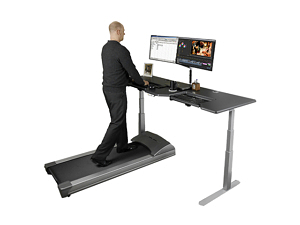Psychological Research Shows Promise of Treadmill Desks

 This guest post is written by Michael Sliter, a workplace fitness researcher at Indiana University-Purdue University Indianapolis.
This guest post is written by Michael Sliter, a workplace fitness researcher at Indiana University-Purdue University Indianapolis.
Why Research Active Workstations?
I first became interested in active workstations when, after five years of graduate school, I realized that I had gained around 25 pounds. As someone who always prided myself on my physical fitness (I played football, softball, racquetball, etc.), the recognition of this slow, insidious weight gain hit me pretty hard.
Around the same time that I had my weight-gain realization, my wife (fiancée at the time) showed me a blog article about a man who created a walking workstation out of a piece of plywood and a treadmill. I remember saying that “someone really needs to be researching these active workstations.”
When you are trying to convince managers of large organizations to change, recommendations based on strong research are crucial. While European organizations care very much about employee health, U.S. organizations want to see bang for their buck. Specifically, most U.S. organizations want information about the performance impact, and benefits, of active workstations before investing any money.
Fast forward three years. I am now researching workplace psychology at Indiana University-Purdue University Indianapolis (IUPUI) and have just published a paper on active workstations at the Journal of Occupational Health Psychology.
Our Study On Active Workstations
Along with a grad student and several undergrads, we conducted an experimental study. The goal was to compare psychological outcomes (i.e., boredom, satisfaction, stress, and arousal) and performance outcomes (i.e., number of tasks completed; number of errors) across four different working conditions: sitting, standing, cycling, or walking. Participants came into the lab and were assigned to one these conditions. They had a chance to make themselves comfortable (adjusted the desk height and speed for the walking workstation, or the resistance for the cycling workstation). At that point, the participant had 15 minutes to practice the work tasks (web-based search, retrieve, and typing tasks), and 35 minutes to actually perform. Afterward, the participants went to a different computer station, and took a brief survey on their satisfaction with the tasks, their feelings of stress and arousal, and their feelings of boredom.
Next, we did our fancy data analysis (actually, it was pretty straightforward for those who have taken an introductory stats course). We found that participants in walking and cycling conditions tended to report higher levels of arousal and lower levels of boredom compared to seated and standing conditions. Additionally, those in the walking condition had lower feelings of stress and higher feelings of satisfaction. Finally, performance was comparable between walking, seated, and standing conditions, and lower for those in the cycling condition.
What does this all mean? These results show that walking workstations might be a feasible intervention for the workplace. People using walking workstations tended to have psychological benefits without performance decrements.
Cycling workstations, on the other hand, might not be as feasible; they did not have as many benefits, and actually resulted in lowered performance. It was interesting to watch; people, while cycling, had trouble stabilizing their arms which impacted their typing. This is consistent with research saying that your arms can’t remain independent while cycling.
Where This Research Is Going?
Our next steps are to actually start testing active workstations as a workplace intervention. We are interested whether providing people with active workstations – and training them in healthy lifestyle decision – will have a beneficial impact on their physical and mental well-being over a long period of time. Short-term benefits do not always translate into long-term benefits. Another important area of future research is to understand the possible negative impact of active workstations. There may be risk-factors associated with such workstations, particularly when they aren’t designed well (e.g., back and wrist pain). Additionally, in a situation where there are shared active workstations, people who do not want to participate might feel singled-out or excluded. It is important to understand, therefore, the broader impact of instituting active workstations into the workplace.
We remain intrigued, though, by the potential for treadmill desks and other active workstations to prevent or mitigate the disease, weight gain, and productivity losses caused by sedentary work styles.
 Michael Sliter received his M.A. and Ph.D. in Industrial/Organizational Psychology from Bowling Green State University. He is currently an assistant professor, teaching in the M.S. program in I/O Psychology at Indiana University-Purdue University Indianapolis. His research focuses on workplace incivility/aggression, emotions, and workplace fitness. Michael’s research has been published in top I/O journals, including Journal of Applied Psychology, Journal of Organizational Behavior, and Journal of Occupational Health Psychology. Most importantly, he also walks about 4 miles per day on his walking workstation.
Michael Sliter received his M.A. and Ph.D. in Industrial/Organizational Psychology from Bowling Green State University. He is currently an assistant professor, teaching in the M.S. program in I/O Psychology at Indiana University-Purdue University Indianapolis. His research focuses on workplace incivility/aggression, emotions, and workplace fitness. Michael’s research has been published in top I/O journals, including Journal of Applied Psychology, Journal of Organizational Behavior, and Journal of Occupational Health Psychology. Most importantly, he also walks about 4 miles per day on his walking workstation.
